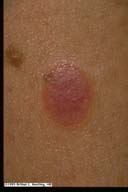Photoessay: The Skin and Diabetes Mellitus
by A Huntley
Dermatology Online Journal, December 1995
Volume 1, Number 2
Necrobiosis Lipoidica
Although necrobiosis is a classic finding in diabetes, it is rather uncommon (less than one percent of diabetics) and may
also occur in persons who do not have the disease. Typical involvement occurs on the legs as bilateral erythematous, brown
or yellow plaques with raised margins and central atrophy. The surface of a lesion often becomes somewhat transparent and
enlarged blood vessels may be seen in the lesion.


Figs 50,51. Legs of two patients with diabetes mellitus who also have necrobiosis lipoidica. The left image demonstrates involvement
of the shin, a typical location for this disease. The right image shows involvement of the posterior aspect of the legs and
demonstrates the bilateral nature of the disease.
Early lesions may present as erythematous papules or plaques. As the lesion expands, the active border remains erythematous
and raised while the center develops atrophy and characteristic translucency.


Figs 52,53 Close-up view of shin lesions in two patients with diabetes mellitus and necrobiosis lipoidica. The left-hand image
is of the early papule stage of necrobiosis lipoidica. The right-hand image demonstrates characteristic translucency and enlargement
of underlying cutaneous blood vessels found in a more advanced lesion.
additional images of necrobiosis lipoidica
All contents copyright (C), 1995.
Dermatology Online Journal
University of California Davis

